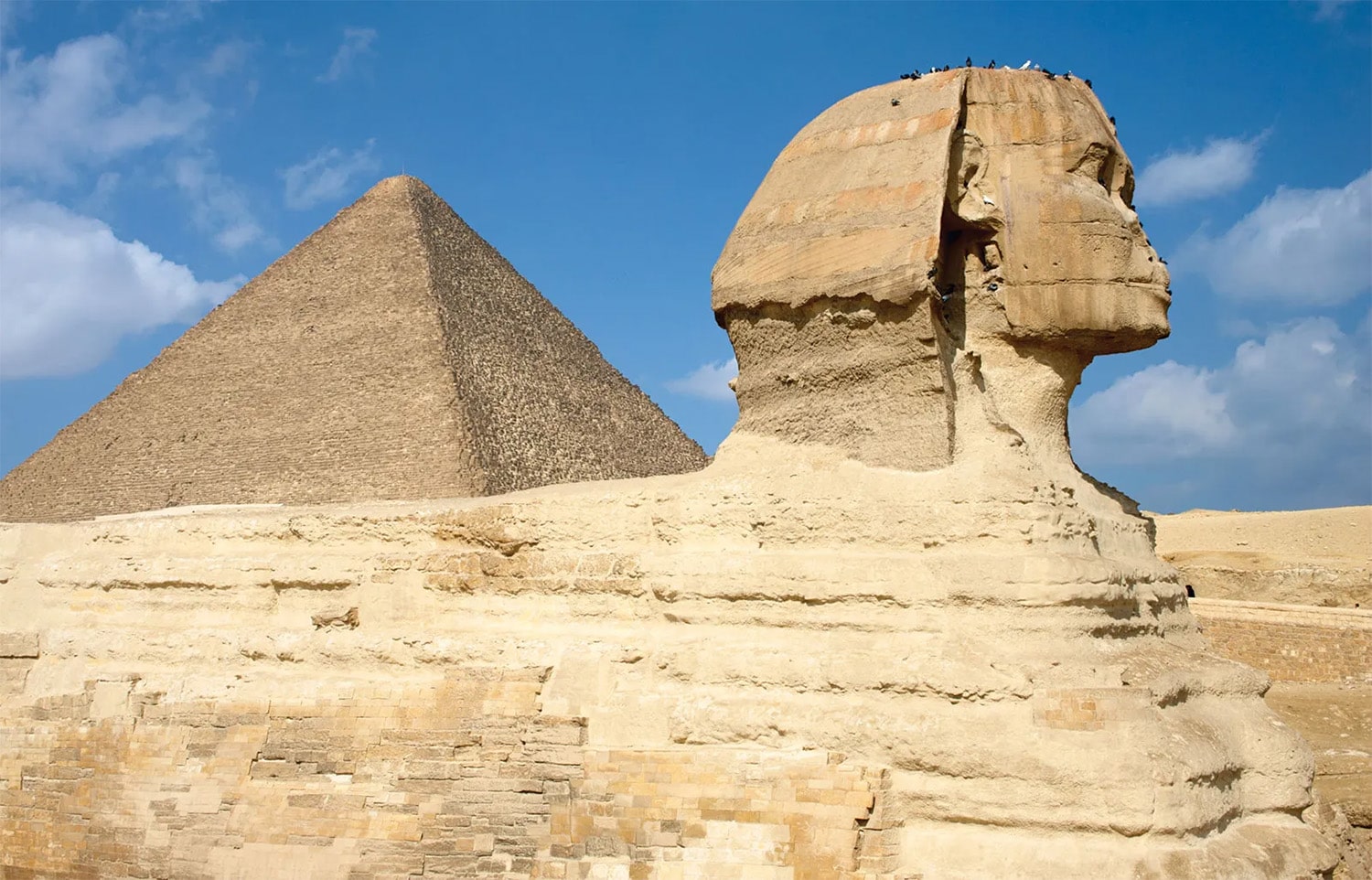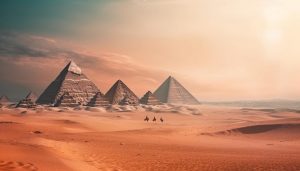
49 interesting facts about The Sphinx
- 👁️ 1023
The Great Sphinx of Giza, an iconic monument that embodies the mystery and grandeur of ancient Egypt, has captivated the imagination of historians, archaeologists, and tourists for centuries. Carved from the limestone bedrock of the Giza Plateau, the Sphinx is renowned for its colossal size, mythical aura, and the enduring enigma surrounding its origins and purpose. This majestic statue, featuring a lion’s body and a human head, is believed to symbolize strength and wisdom, guarding the Giza Necropolis with a serene yet formidable presence. As we delve into the depths of its history and symbolism, the Sphinx continues to offer insights into the sophisticated civilization that crafted such an enduring monument.
- The Sphinx is located on the Giza Plateau, near the Great Pyramids of Giza, on the western bank of the Nile River.
- It is one of the world’s largest and oldest statues, but basic facts about it, such as when it was built and by whom, are still debated.
- Most Egyptologists believe the Sphinx was built during the reign of Pharaoh Khafre (2558–2532 BC).
- The Sphinx faces the rising sun and is believed to have been a symbol of solar worship in the Old Kingdom.
- It is 73 meters (240 feet) long and 20 meters (66 feet) high, making it the largest monolithic statue in the world.
- The Sphinx is carved directly out of the bedrock and consists of a lion’s body with a human head.
- The human head is generally believed to be that of Pharaoh Khafre.
- Over the millennia, the Sphinx has suffered considerable erosion, primarily due to wind and sand.
- The Sphinx’s nose is missing; numerous myths exist about its destruction.
- The most popular legend claims that the nose was broken off by a cannonball fired by Napoleon’s soldiers in 1798.
- However, sketches of the Sphinx by Frederick Lewis Norden made in 1737, before Napoleon’s campaign, already depict the Sphinx without a nose.
- The actual cause of the nose’s destruction remains unknown, with some suggesting it was purposefully vandalized in the past to symbolize a defeat.
- The Sphinx has been excavated multiple times; the first documented excavation was in the 18th century by the Dane, Frederic Louis Norden.
- In the 19th century, the Sphinx was excavated more systematically by Giovanni Battista Caviglia.
- The Sphinx was buried up to its shoulders in sand until the early 20th century when the sand was cleared away to reveal the base and surrounding temple.
- In front of the Sphinx is a temple, known as the “Sphinx Temple,” which is aligned with the statue itself.
- This temple and the Sphinx are part of a larger complex that includes the Valley Temple and the Great Pyramid of Khafre.
- The Sphinx is thought to have been painted originally, and traces of red pigment are still visible on its face.
- There are no inscriptions on the Sphinx itself that unambiguously identify the king it represents or its exact purpose.
- The dream stela placed between the paws of the Sphinx by Thutmose IV tells a story of how the young prince had a dream in which the Sphinx promised him kingship if he cleared away the sand covering its body.
- This stela is a crucial artifact linking the Sphinx to solar worship, indicating a rejuvenation of the cult of the sun god Ra.
- The Sphinx has undergone numerous restoration projects in modern times to combat erosion and decay.
- These restorations have sometimes been controversial due to the methods used and the materials introduced.
- The Sphinx continues to be a symbol of mystery, and numerous theories about hidden chambers or tunnels beneath it persist to this day.
- Seismic studies indicate there may be cavities or tunnels underneath the Sphinx, but nothing conclusive has been found.
- The Sphinx’s Giza Necropolis is listed as a UNESCO World Heritage Site.
- It has become an icon of Egyptian national identity and a symbol of antiquity’s enigmatic allure.
- The Sphinx appears in numerous books, movies, and documentaries, often depicted as guarding ancient secrets.
- The Arabic name for the Sphinx is “Abu al-Hol,” meaning “Father of Terror.”
- The Sphinx’s design is thought to be influenced by the solar god Atum, who was believed to take the form of a lion on earth.
- The Sphinx, with its lion’s body, may symbolize royal power, and the human head, the intelligence of the pharaoh.
- The Sphinx’s lion body aligns with the constellation Leo, which has led some to speculate about astrological significance.
- The Sphinx’s erosion patterns are different on its body and head, suggesting different construction phases or materials.
- The Sphinx has been a pilgrimage site for centuries, visited by travelers and scholars who wrote about its deteriorating condition.
- In medieval times, the Sphinx was commonly believed to represent the likeness of a pharaoh named Harmakhis.
- The paws of the Sphinx are 15 meters (50 feet) long.
- It’s one of the few remaining wonders of the ancient world that one can still visit in person.
- The Sphinx, despite its age and weathering, still retains detailed facial features which highlight sophisticated craftsmanship.
- Legends and myths often describe the Sphinx as a riddle-solver, which is a metaphor for its mysterious nature.
- The stone blocks used for the Sphinx Temple were quarried from the Sphinx enclosure itself.
- Archaeologists continue to explore the layers of sediment around the Sphinx to better understand its environmental history.
- In ancient times, the Sphinx was revered, with pharaohs and common people alike offering it worship.
- The Sphinx has a tail that wraps around its right flank, which is consistent with depictions of lions in Egyptian art.
- The Sphinx has been the subject of many esoteric theories, including those linking it to lost civilizations or extraterrestrial influences.
- Erosion analysis suggests that some of the Sphinx’s most severe weathering could have occurred from rainfall, which has implications for dating its construction.
- Despite its age, the Sphinx has no definitive records of its construction or original purpose in ancient texts.
- The Sphinx faces due east, watching the sunrise every day, which is a testament to its intended symbolism of solar alignment and renewal.
- The Sphinx is smaller in scale compared to the nearby pyramids, but its detailed and precise construction demands equal admiration.
- The mystery of the Sphinx’s missing beard and whether it was originally bearded like a pharaoh remains part of its allure.
The Great Sphinx of Giza, through its enduring presence, continues to be a testament to ancient Egypt’s grandeur and architectural prowess. Despite the wear of centuries, it stands as a sentinel of history, offering insights and raising questions that keep both scholars and tourists enchanted. Its blend of mythological significance and historical presence makes it a cornerstone of archaeological study and a perennial symbol of Egypt’s ancient mysteries.








